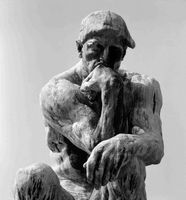Anyone Can Write A Poem
Anyone can write a poem, but,
To call oneself a poet is another thing.
To be a poet calls for gift:
Humdrum persistence,
(Some would call it patience)
Mulling over, musing on; but with distance.
Facets focusing upon all faces:
Places, spaces, graces…
And their antonyms; the oxymorons.
To call oneself a poet is another thing.
To be a poet calls for gift:
Humdrum persistence,
(Some would call it patience)
Mulling over, musing on; but with distance.
Facets focusing upon all faces:
Places, spaces, graces…
And their antonyms; the oxymorons.
If anyone can write a poem, write one!
If you like it, write another.
You and I are everyman: unsung, unclear.
Become a thinker, sluice and duct;
Avenue for inner construct.
Everything has drama: kitty’s purr,
Dying fir, cowboy’s spur…
The insignificant betrays a stir
That sits within a coma.
All is magma in the planet’s inner.
You, the [unknown] poet winner.
If you like it, write another.
You and I are everyman: unsung, unclear.
Become a thinker, sluice and duct;
Avenue for inner construct.
Everything has drama: kitty’s purr,
Dying fir, cowboy’s spur…
The insignificant betrays a stir
That sits within a coma.
All is magma in the planet’s inner.
You, the [unknown] poet winner.


Le Penseur (The Thinker) -- Auguste Rodin
"What makes my Thinker think is that he thinks not only with his brain, with his knitted brow, his distended nostrils and compressed lips, but with every muscle of his arms, back, and legs, with his clenched fist and gripping toes." -- Auguste Rodin
ReplyDeleteIn 1880 France's Ministry of Fine Arts commissioned Rodin to design his 1st large-scale public project, a 20-ft entrance portal for a yet-to-be constructed Musée des Arts Décoratifs in Paris. Inspired by Lorenzo Ghiberti’s 15th-century "Gates of Paradise" to the north entrance of Firenze's Battistero di San Giovanni, Rodin dubbed it "The Gates of Hell" because he planned to illustrate scenes from Dante's 14th-century "Inferno." He intended to place a 27.5-in (70 cm) representation of Dante on the tympanum above the doors, contemplating the creation of his epic poem. Indeed, he always referred to the statue as "Le Poète," but the foundry workers dubbed it "The Thinker." The sculptor never completed the huge work in a definitive form, though he worked on it intermittently until 1900; the museum itself never came into being in its proposed form (its proposed site is now the Musée d’Orsay, and "The Gates of Hell" was never cast during Rodin's lifetime), but he began exhibiting many of the planned figures as freestanding sculptures before the end of the decade. Altogether, the project served as the source of at least 200 individual pieces, including some of his best-known works. In 1884 Rodin crafted an early version of "The Thinker" wearing a Florentine-style cap for a collector in England, but he never exhibited early versions. In 1888 he finally conceived the work in its final form and made a 72-in plaster model, which he exhibited at the Galerie Georges Petit. A 6-ft bronze-painted version was made in 1902 and was shown at the Spring Salon in Paris in 1904, the same year a bronze copy was displayed at the St. Louis World's Fair in the US. The French government bought the plaster model and placed it in front of the Panthéon but a month and 1/2 later a deranged man destroyed it. Rodin created a new bronze version, which was installed at the Panthéon in 1906. Rodin said that “It magnifies the thought of those humble people of the soil who are nevertheless producers of powerful energies. It is in itself a social symbol.” In 1922 it was removed because it was an obstacle to public events (and because it had taken on socialist connotations due to its creator's remarks) and was taken to the Musée Rodin, which had opened in 1919 at the former Hôtel Biron where he had established his workshop in 1908. During his lifetime Rodin approve 10 bronze castings of the sculpture for various institutions around the world. One of the final monumentals approved by him was purchased by the Cleveland Museum of Art in 1916; it was dynamited in 1970 by the Weather Underground -- the lower legs and pedestal were irreparably damaged but the rest was preserved : the rock beneath the man is splayed into bent petals but his thoughts remain unperturbed. (Similarly, his 1st bust, "The Man with a Broken Nose," had originally been a full figure but the clay model had accidentally been broken at the neck, the nose flattened and made crooked, and the back of the head destroyed.)
"Guided by my first inspiration I conceived another thinker, a naked man, seated on a rock, his fist against his teeth, he dreams. The fertile thought slowly elaborates itself within his brain. He is no longer a dreamer, he is a creator." -- Rodin